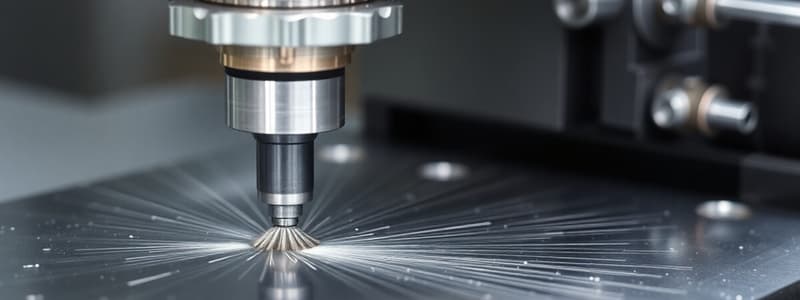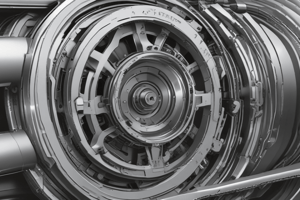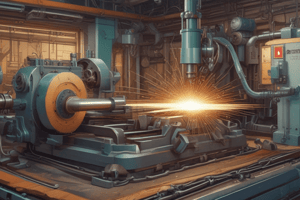Podcast
Questions and Answers
List three essential conditions that should be met for effective metal cutting, focusing on the properties of the tool and the applied forces.
List three essential conditions that should be met for effective metal cutting, focusing on the properties of the tool and the applied forces.
The tool material should be harder than the workpiece, the cutting force applied should exceed the workpiece's strength, and the tool geometry should facilitate efficient chip formation and cutting action.
Explain the difference between orthogonal and oblique metal cutting processes based on the orientation of the cutting edge relative to the cutting direction.
Explain the difference between orthogonal and oblique metal cutting processes based on the orientation of the cutting edge relative to the cutting direction.
In orthogonal cutting, the tool's cutting edge is perpendicular (90°) to the cutting direction, resulting in a two-dimensional cutting action. In oblique cutting, the cutting edge is inclined at an angle less than 90° to the cutting direction, leading to a three-dimensional cutting process.
Describe the main difference between single-point and multi-point cutting tools and provide an example of each.
Describe the main difference between single-point and multi-point cutting tools and provide an example of each.
Single-point cutting tools have one cutting edge, such as those used in turning on a lathe. Multi-point cutting tools have multiple cutting edges, as seen in milling cutters or drills.
Explain what is meant by 'tool geometry' in the context of metal cutting and list three angles that define the geometry of single-point cutting tools.
Explain what is meant by 'tool geometry' in the context of metal cutting and list three angles that define the geometry of single-point cutting tools.
Describe the function of 'rake angle' in cutting tools and how positive, zero, and negative rake angles affect cutting performance.
Describe the function of 'rake angle' in cutting tools and how positive, zero, and negative rake angles affect cutting performance.
List and briefly describe the three main types of chips produced during metal cutting.
List and briefly describe the three main types of chips produced during metal cutting.
In the context of metal cutting, what do the terms 'Shear Angle' and 'Rake Angle' refer to, and how do they influence the cutting process?
In the context of metal cutting, what do the terms 'Shear Angle' and 'Rake Angle' refer to, and how do they influence the cutting process?
Describe the purpose of using American Standard Association (ASA) tool designation system in machining.
Describe the purpose of using American Standard Association (ASA) tool designation system in machining.
Explain the key difference between ASA and ORS (Orthogonal Rake System) tool designation.
Explain the key difference between ASA and ORS (Orthogonal Rake System) tool designation.
Describe the working principle of a lathe machine in terms of how it shapes a workpiece.
Describe the working principle of a lathe machine in terms of how it shapes a workpiece.
Classify lathe machines based on purpose of use, providing one example for each category.
Classify lathe machines based on purpose of use, providing one example for each category.
How does size or capacity classify lathe machines, and what are three common size classifications?
How does size or capacity classify lathe machines, and what are three common size classifications?
List three ways to classify lathe machines based on the configuration of the jobs being handled.
List three ways to classify lathe machines based on the configuration of the jobs being handled.
Describe two classifications of lathe machines based on their precision.
Describe two classifications of lathe machines based on their precision.
List two classifications of lathe machines based on the number of spindles they utilize.
List two classifications of lathe machines based on the number of spindles they utilize.
Name three classifications of lathe machines based on degree of automation.
Name three classifications of lathe machines based on degree of automation.
Describe three key specifications that define the capacity and capabilities of a lathe machine?
Describe three key specifications that define the capacity and capabilities of a lathe machine?
Name five main parts of a lathe machine.
Name five main parts of a lathe machine.
List three types of accessories used for mounting jobs in center lathes without tailstock support.
List three types of accessories used for mounting jobs in center lathes without tailstock support.
Name three common accessories used for mounting tools in Centre lathes.
Name three common accessories used for mounting tools in Centre lathes.
What are two types of tool mounting options used in automatic lathes?
What are two types of tool mounting options used in automatic lathes?
Identify five operations that can be performed on a lathe machine.
Identify five operations that can be performed on a lathe machine.
Explain the purpose of Cutting Speed, Feed, and Depth of Cut.
Explain the purpose of Cutting Speed, Feed, and Depth of Cut.
Describe the working principle of a drilling machine, explaining how it creates holes in a workpiece.
Describe the working principle of a drilling machine, explaining how it creates holes in a workpiece.
List two primary classifications of drilling machines.
List two primary classifications of drilling machines.
What are the key specifications considered when selecting a drilling machine?
What are the key specifications considered when selecting a drilling machine?
Describe the use of 'jigs' and 'fixtures' in drilling.
Describe the use of 'jigs' and 'fixtures' in drilling.
What are the most common types of 'tool' used in drilling?
What are the most common types of 'tool' used in drilling?
Operations on drilling machine?
Operations on drilling machine?
Distinguish between 'fixed automation' and 'flexible automation' and lathe machines.
Distinguish between 'fixed automation' and 'flexible automation' and lathe machines.
What is the main purpose of using cutting fluids in machining operations?
What is the main purpose of using cutting fluids in machining operations?
Describe machine's cutting process
Describe machine's cutting process
Describe the importance of specifying tool parameters?
Describe the importance of specifying tool parameters?
Classify cutting tools.
Classify cutting tools.
Describe classification according to construction.
Describe classification according to construction.
Flashcards
Cutting tool material
Cutting tool material
Material used for cutting should be harder than the workpiece.
Cutting force
Cutting force
The force applied must exceed the workpiece's strength to achieve cutting.
Cutting tool geometry
Cutting tool geometry
It includes rake angle, relief angle, and cutting edge geometry.
Orthogonal cutting process
Orthogonal cutting process
Signup and view all the flashcards
Orthogonal Cutting Edge
Orthogonal Cutting Edge
Signup and view all the flashcards
Oblique cutting process
Oblique cutting process
Signup and view all the flashcards
Oblique Cutting Edge
Oblique Cutting Edge
Signup and view all the flashcards
Single point cutting tool
Single point cutting tool
Signup and view all the flashcards
Multi point cutting tool
Multi point cutting tool
Signup and view all the flashcards
Solid tools
Solid tools
Signup and view all the flashcards
Tipped cutting tools
Tipped cutting tools
Signup and view all the flashcards
Rake angle
Rake angle
Signup and view all the flashcards
Positive Rake Angle Benefit
Positive Rake Angle Benefit
Signup and view all the flashcards
Zero Rake Angle Benefit
Zero Rake Angle Benefit
Signup and view all the flashcards
Negative Rake Angle Benefit
Negative Rake Angle Benefit
Signup and view all the flashcards
Relief / Clearance angle
Relief / Clearance angle
Signup and view all the flashcards
Continuous chips
Continuous chips
Signup and view all the flashcards
Discontinuous chips
Discontinuous chips
Signup and view all the flashcards
Built-up edge chips
Built-up edge chips
Signup and view all the flashcards
Cutting Speed (V)
Cutting Speed (V)
Signup and view all the flashcards
Feed (f)
Feed (f)
Signup and view all the flashcards
Depth of Cut (t)
Depth of Cut (t)
Signup and view all the flashcards
Lathe Machine Working
Lathe Machine Working
Signup and view all the flashcards
General Purpose Lathe
General Purpose Lathe
Signup and view all the flashcards
Single Purpose Lathe
Single Purpose Lathe
Signup and view all the flashcards
Special Purpose Lathe
Special Purpose Lathe
Signup and view all the flashcards
Small Lathe
Small Lathe
Signup and view all the flashcards
Medium Lathe
Medium Lathe
Signup and view all the flashcards
Large Lathe
Large Lathe
Signup and view all the flashcards
Mini Lathe
Mini Lathe
Signup and view all the flashcards
Drilling Machine Working
Drilling Machine Working
Signup and view all the flashcards
Drill Machine Specifications
Drill Machine Specifications
Signup and view all the flashcards
Drilling machine operations.
Drilling machine operations.
Signup and view all the flashcards
Study Notes
Fundamentals of Machining & Machining Operations
- Unit I focuses on the fundamentals of machining and machining operations.
- Course outcomes involve producing jobs using lathe and drilling machines.
- This unit accounts for 14 marks.
Mechanism of Metal Cutting
- Metal cutting conditions require the cutting tool material to be harder than the workpiece.
- Applied cutting force must exceed the workpiece strength.
- Cutting tool geometry is a key factor.
- Key angles in metal cutting include rake angle (µ), shear angle (f), and relief angle (r).
- An uncut chip has a thickness denoted as t, while the chip thickness after the cut is tc.
Types of Metal Cutting Processes
- Metal cutting processes can be categorized into orthogonal and oblique cutting.
Orthogonal Cutting Process
- Is a two-dimensional cutting process
- The tool cutting edge is at 90° to the line of action/path of the tool, and the cutting velocity vector.
- Cutting involves only two forces
- Is simpler to analyze.
Oblique Cutting Process
- Is a three-dimensional cutting process.
- The cutting edge is inclined at less than 90° to the line of action/path of the tool and cutting velocity vector.
- Analysis is more difficult compared to orthogonal cutting.
Types of Cutting Tools
- Cutting tools are classified based on the number of cutting points.
- Single point cutting tools exists
- Multi point cutting tools exists
- Tool construction determines whether they are solid or tipped.
Cutting Tool Geometry
- Aspects include the shank, face, flank, principal flank, auxiliary flank, rake angle, back rake angle, and side rake angle.
- Relief angle also is factor, including side and end relief angles
- Cutting angles include side and end cutting edge angles
- Tool nose radius is another factor
Cutting Tool Geometry - Rake Angle
- Rake angles ensure ease of chip flow during machining.
- A positive rake angle reduces cutting force and power requirements.
- A zero rake angle simplifies design and manufacturing.
- A negative rake angle increases edge-strength and tool life.
Cutting Tool Geometry - Relief / Clearance Angle
- Prevents rubbing between the tool (flank) and the machined surface.
Types of Chips
- Chips formed during cutting process are classified as continuous, discontinuous and built-up edge (BUE).
- Continuous chips are formed from ductile materials at high cutting speeds, fine feeds, with positive, large rake angle and cutting fluid
- Discontinuous chips are produced from brittle materials/ductile but hard with medium-high cutting speeds, large feeds, negative rake angle and cutting fluid is absent.
- Continuous with BUE chips are formed from ductile materials at low cutting velocity, medium/large feed, small/negative rake angle and cutting fluid is absent
Cutting Forces
- Several forces are involved in metal cutting: shear force at shear plane (Fs), normal force at shear plane (Fn), and the resultant force of Fs and Fn (R').
- Tangential force on the tool face (F).
- Normal force on the tool face acting on the chip (N).
- The resultant force of F and N is denoted as R
- Horizontal component of the cutting force (Fc).
- Vertical component or Thrust force (Ft).
- Shear stress on the shear plane (τs).
- Rake angle of the cutting tool (α).
- Coefficient of friction (µ).
- Angle of friction (ß).
- Shear Angle (Φ)
Force Expressions
- Shear force = Fs = Fc * cos(φ) - Ft * sin(φ).
- Normal force = Fn = Fc * sin(φ) + Ft * cos(φ)
- Tangential frictional force: F = Fc * sin(α) + Ft * cos(α)
- Normal force is expressed as: N = Fc * cos(α) - Ft * sin(α)
- Shear Angle can be found by φ =tan^-1( (r * cos α) / (1 -r sin α) )
- Coefficient of friction: μ = tan β = (Fc tan α + Ft) / (Fc - Ft tan α).
Cutting Tool Designation
- ASA (American Standard Association System) and ORS (Orthographic Rake System) are used
ASA Tool Designation
- Includes angles like side cutting edge angle (Cs), end cutting edge angle (Ce), side relief angle (Os), end relief angle (Oe), side rake angle (αs), & back rake angle (αb).
ORS Tool Designation
- Involves side relief angle (γ), side rake angle (α), wedge/lip angle (β), cutting angle (δ), back rake/inclination angle (i), end relief angle(γ1), end cutting edge angle (Ce).
Lathe Machine Fundamentals
- Working principle: The workpiece is held in a spindle-mounted chuck and turned against a cutting tool to remove material in the form of chips.
- Classification is based on configuration, purpose of use, size or capacity, and the configuration of jobs handled.
Classification by Configuration
- Horizontal lathes
- Vertical lathes
Classification by Purpose of Use
- General-purpose lathe machines handle all types of operations.
- Single-purpose serve one type of operation
- Special-purpose lathe machines repeat specific operations.
Classification by Size or Capacity
- Small/low duty handles small to medium jobs.
- Medium duty lathes are versatile and commonly used.
- Large/heavy duty lathes handle large jobs.
- Mico/mini handles small size precision work
Classification by Configuration of Jobs Handled
- Bar type lathe machines hold jobs in collets.
- Chuck type lathe machines hold jobs in chucks.
- Housing type lathe machines handle odd-shaped jobs on a face plate.
Classification by Precision
- Ordinary lathe are standard machines
- Precision lathe machines gives high accuracy
Classification by Number of Spindles
- Single spindle lathe machines standard single operation machines
- Multiple lathe operations does fast and mass production
Classification by Type of Automation
- Fixed automation lathe machines utilize conventional single spindle automats.
- Flexible automation lathe machines use modern CNC lathes and Turing centres.
Classification by Degree of Automation
- Non-automatic lathe machines are conventional.
- Semi-automatic lathe machines are copying lathes.
- Automatic lathe machines are single spindle automat.
Lathe Machine Specification
- Includes maximum job diameter and length.
- Power of the main drive
- Range of spindle speeds and feeds
- Space occupied by the machine.
Lathe Machine Parts
- Consists of a headstock, tailstock, bed, carriage, cross slide, compound rest, tool post, and lead screw.
Lathe Machine Accessories - Centre Style
- Mounting jobs in Centre lathes is done without additional tailstock support.
- Chucks (3-jaw self-centering, 4 independent jaw)
- Face plates
- Jigs and fixtures.
- With tailstock support includes
- In-between Centre
- In-between chuck and Centre
- In-between headstock and tailstock
Lathe Machine Accessories - CNC Style
- Coventry concentric chucks
- Air operated chucks,
- Quick acting soft jaw chucks
- Collet chucks
Lathe Machine Accessories - Tool Mounting
- HSS tools (shank type)
- HSS form and threading tools
- Carbide and ceramic inserts
- Drills and reamers
- Boring tools
Lathe Machine Accessories - Automatic Style
- Radial slides (front and rear)
- Turrets (mostly hexagonal) for tool mounting
Lathe Machine Operations
- Straight turning
- Taper turning
- Profiling
- Turning and external grooving
- Facing
- Face grooving
- Cutting with a form tool
- Boring and internal grooving
- Drilling
- Cutting off
- Threading
- Knurling
Lathe Machine Cutting Parameters
- Cutting Speed (V): Is the speed at which metal is removed, expressed in m/min or mm/min; calculated as V = πDN / 1000.
- Feed (f): Relative motion of the cutting tool in one workpiece revolution; expressed in mm/rev.
- Depth of Cut (t): The total metal removed per pass, expressed in mm, varies with tool type and material.
Drilling Machine Fundamentals
- Working principle involves producing holes by using a rotating cutter called a drill.
- The machine tool exerts vertical cutting force to create a hole.
Drilling Machine Classification
- Portable drilling machines, accommodating 12 to 18 mm drill sizes.
- Sensitive drilling machines, available as table top (0.5 kW, 10 mm) and floor mounting (1.5 to 15.5 mm).
- Upright drilling machines. Pillar (0.55 - 1.1 kW, 50 mm). Box column construction
Drilling Machine Classifications
- Gang drilling machines use 2 to 6 spindles with variable drills simultaneously.
- Multi-spindle are central with a planetary gear system using variable drills on a telescopic part
- Turret-type which is column type with a turret that holds no drills
Drilling Machine Specifications
- Specifications include the maximum drill size (diameter), hole size and taper in the spindle.
- Also the range of spindle speeds and feeds
- Power of the main drive
- Axial travel range of the spindle/bed
- Floor space occupied
Drilling Machine Accessories - Job Mounting
- Angle, drilling, and diameter jigs.
- Plate jibs
- Vices for clamping work
Drilling Machine Accessories - Tool Mounting
- Drill sleeves
- Drilling chucks
- Tapping tool mountings
Drilling Machine Operations
- Reaming
- Tapping
- Counter-boring
- Counter-sinking
- Centre drilling
- Spot facing
Studying That Suits You
Use AI to generate personalized quizzes and flashcards to suit your learning preferences.





